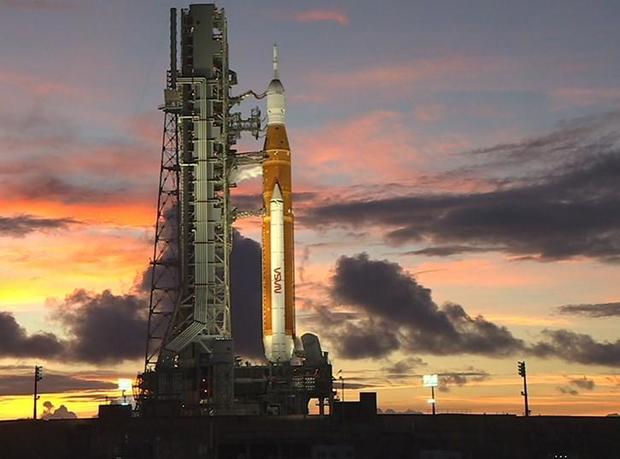Launch of NASA’s Artemis 1 test flight postponed after issues arise
After months of tests, troubleshooting and repairs, NASA ran into problems during fueling of the Space Launch System moon rocket early Monday, forcing the agency to scrub the planned launch of its Artemis 1 test flight — a critical mission to send an unpiloted Orion crew capsule on a 42-day mission beyond the moon and back.
Launch originally was planned for 8:33 a.m. EDT, the opening of a two-hour window. The next opportunity for launch will be Friday, Sept. 2, at 12:48 p.m. EDT, if the problems are resolved by then.
The countdown was paused overnight because of stormy weather and troubleshooting to resolve an apparent hydrogen leak, 750,000 gallons of super-cold liquid oxygen and hydrogen fuel were loaded into the SLS core stage, clearing the way for another 22,000 gallons to be pumped into the upper stage.
The Artemis 1 test flight is intended to verify the rocket’s ability to propel Orion capsules into Earth orbit and then onto the moon. Engineers also will test the crew ship’s myriad systems in deep space and make sure its heat shield can protect returning astronauts from the 5,000-degree heat of re-entry.
NASA
NASA plans to follow the uncrewed Artemis 1 mission by launching four astronauts on a looping around-the-moon flight in 2024, setting the stage for the first astronaut landing in nearly 50 years when the first woman and the next man step onto the surface in the 2025-26 timeframe.
But first, NASA must prove the rocket and capsule will work as planned — and that begins with the Artemis 1 launch.
Fueling was delayed 55 minutes by an approaching storm and lightning within about 6 miles of launch pad 39B. The six-hour fueling procedure began about 1:13 a.m. only to be interrupted by indications of a hydrogen leak near the area where propellant lines enter the base of the rocket.
During a transition from “slow fill” to a 10 times faster rate, sensors detected higher-than-allowable concentrations of hydrogen, indicating a leak somewhere in the system. After reverting back to slow fill and enabling temperatures to equalize across the plumbing, fast fill was restarted and this time, there were no issues.
Still to be determined: the status of a 4-inch quick-disconnect fitting used to route hydrogen to the core stage engines to cool them prior to ignition. NASA reported three of the engines were being properly conditioned, but engine No. 3 did not initially “see” the desired flow rates. That prompted additional troubleshooting.
And if that wasn’t enough, an unusual line of frost was spotted on the exterior of the rocket’s core stage – a possible indicator of a leak of some sort, a crack in thermal insulation or some other issue.
Engineers were hopeful the issues could be resolved before the end of the two-hour launch window. Backup launch opportunities are available on September 2 and 5. If the rocket isn’t off the pad by then, the SLS will have to be hauled back to the Vehicle Assembly Building for servicing.
For all the latest Entertainment News Click Here
For the latest news and updates, follow us on Google News.



